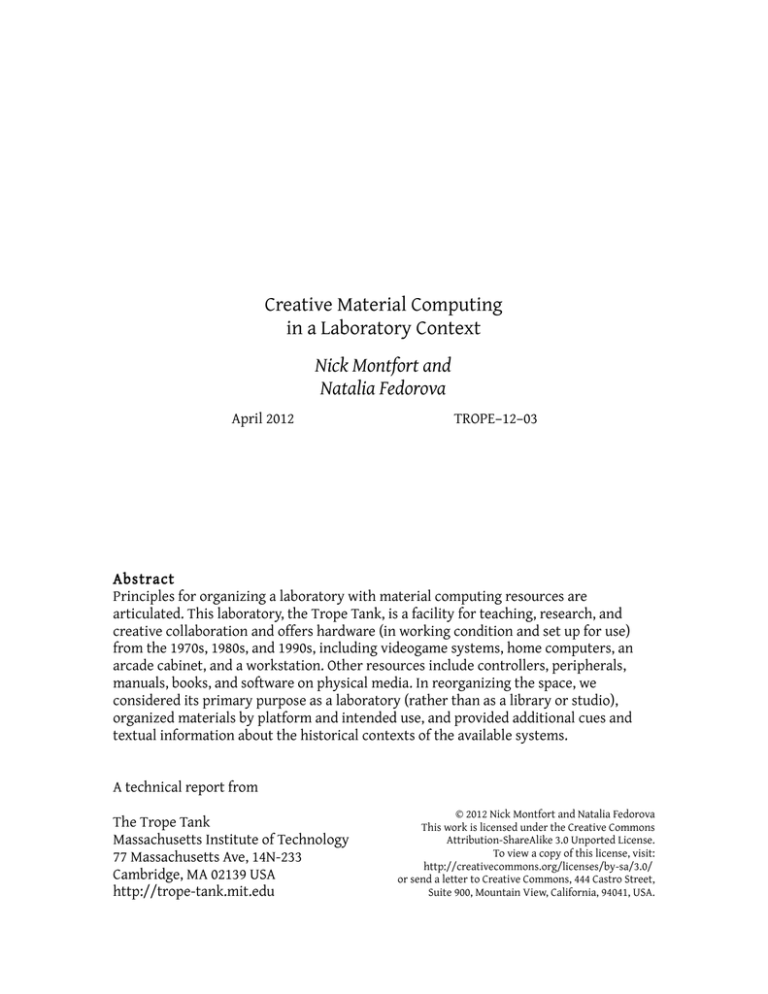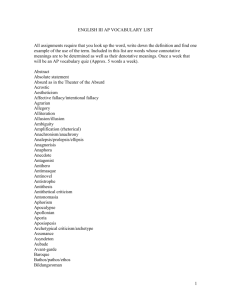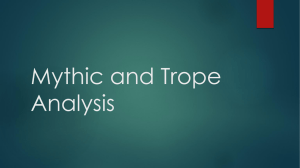Creative Material Computing in a Laboratory Context Nick Montfort and Natalia Fedorova
advertisement

Creative Material Computing in a Laboratory Context Nick Montfort and Natalia Fedorova April 2012 TROPE–12–03 Abstract Principles for organizing a laboratory with material computing resources are articulated. This laboratory, the Trope Tank, is a facility for teaching, research, and creative collaboration and offers hardware (in working condition and set up for use) from the 1970s, 1980s, and 1990s, including videogame systems, home computers, an arcade cabinet, and a workstation. Other resources include controllers, peripherals, manuals, books, and software on physical media. In reorganizing the space, we considered its primary purpose as a laboratory (rather than as a library or studio), organized materials by platform and intended use, and provided additional cues and textual information about the historical contexts of the available systems. A technical report from The Trope Tank Massachusetts Institute of Technology 77 Massachusetts Ave, 14N-233 Cambridge, MA 02139 USA http://trope-tank.mit.edu © 2012 Nick Montfort and Natalia Fedorova This work is licensed under the Creative Commons Attribution-ShareAlike 3.0 Unported License. To view a copy of this license, visit: http://creativecommons.org/licenses/by-sa/3.0/ or send a letter to Creative Commons, 444 Castro Street, Suite 900, Mountain View, California, 94041, USA. 2 The Lab’s Mission To develop new poetic practices and new understandings of digital media by focusing on the material, formal, and historical aspects of computation and language. The Trope Tank is a laboratory for creative computing. A particular focus is on language and poetics, but resources of many sorts are available – including material systems, software on physical media, controllers, peripherals, manuals, and books. Most computer systems are set up, plugged in, and ready for use. We aim to provide the easiest and best access to material computing resources for digital media researchers, teachers, and those collaborating with affiliates of the Trope Tank on creative projects. The Trope Tank has three main purposes: 1. Teaching The resources of The Trope Tank can help visitors understand more about the material nature of home computing and videogaming and can help them to understand the immediate contexts of software and systems by allowing the use of hardware alongside manuals, boxes, and books; with software on physical media; and before or after experiencing other systems from the same era and surrounding eras. While software can be run in emulation (which is extremely useful in teaching and research) and while many manuals and books have been scanned, the Trope Tank provides access to qualities of these materials that are not carried over, even in the best emulations. Students can experience how systems are powered up; what happens upon startup; what standard displays of previous decades look like and how text and graphics appear on them; how programs are loaded from cartridge, tape, disk or how they are typed in; and how keyboards and controllers work and feel to the user. Knowledge gained from practical experience and interaction with systems is often more profound, more memorable, and more enjoyable. A carefully designed class that allows students to work with machines from different eras, or different sorts of systems that were contemporary with each other, can provide a unique historical or media archaeological perspective. Being able to look at numerous games for a many-decades-old game console – including launch titles, ones developed a few years later, ones developed in the late commercial phase of that console, and recent hobbyist programs – can show the way in which the constraints and cultural context of particular platform can enable creativity. It can also reveal how the discovery of new techniques allows the same hardware to develop different uses over time. 2. Research The Trope Tank is meant to help in the investigation of the material properties of computer systems, how they relate to computing in the corresponding era, and how they fill in the understanding of computing that can also be gained from readings and analysis of software, interviews, and other methods. Many centuries of textual studies have shown the importance of considering all available manuscripts and drafts to thoroughly trace the the genealogy of a particular 3 published work. Access to a prototype of a particular game, or other variant versions of a game, can in the same way provide information about a programmer or a development team's creative process. Being able to use the hardware employed by the author or by early users can also shed light on the production and the early aesthetic and material reception of a particular piece. As a practical matter, there are cases in which it is not only closer to the original situation of programming and use, but also actually easier, to run early programs on the original hardware rather than in emulation or via some migrated version. Such cases particularly suggest the use of older systems in the Trope Tank. At another level, it is worthwhile to be able to consider and use different forms of physical media, with their different capabilities for sequenial or random access, for resisting or inviting modification (as seen in the two-sided “flippy disk”), and for providing programs and data at different rates of speed. The materials used in the case of a computer, console, or other piece of hardware are significant, too, as direct observation of and experience of hardware can reveal. A portable print terminal’s resemblance to a typewriter suggested the desk as a place where it should sit in the house, while the Atari VCS with its faux-wood-grain case decoration suggested that it would be right at home near the stereo and TV set, in the living room. One example of research facilitated by (although not conducted exclusively in) the Trope Tank is the book 10 PRINT CHR$(205.5+RND(1)); : GOTO 10, coming from The MIT Press in November 2012 [1]. Ten authors from around the United States, including three from MIT, collaborated to write this book, which is about a one-line Commodore 64 BASIC program of the sort developed and disseminated by hobbyists (frequently in print, in magazines and books) in the 1980s. Three of these authors (including Nick Montfort, the organizer) were local to MIT and worked at times in the Trope Tank, using the Commodore 64 with Commodore 1702 monitor, software, and peripherals as well as books and magazines that pertained to BASIC and the Commodore 64. The Trope Tank also hosted the MediaWiki used to write the book. 3. Collaboration on Creative Projects Creating a new work of digital writing or art often requires an understanding of the nature of the platform and the way in which it supports, shapes and constraints new work. (Writers and artists using digital media skillfully usually develop a strong awareness of platform, but are not always able to articulate their insights and sense for the relevant properties of a platform, making collaboration difficult.) Looking at older creative projects, which can be seen as innovative from a historical perspective and can be clearer in exposing the relationship between work and platform, is likely to be productive for contemporary creators. The Trope Tank laboratory can inspire and help with the development of translations and remixes of old works. It can also aid in creating new works that play with traditional associations that have been built up over the decades. Arranging the Space In doing some reorganization of the lab space in April 2012, we decided to make three guiding principles related to this facility and its arrangement explicit: 4 1 The Trope Tank is mainly a laboratory, not mainly a library or studio. There is a collection of materials that include books and software in the Trope Tank, but it is not meant mainly to serve as a library. The facility is used for creative work and digital media production, but it is not devoted to such work as a studio is. The distinction between a library and a laboratory bears on the approach to classifying, storing, and providing access to materials. The quality of a library is often judged on the variety and appropriateness of its resources; it serves as a way to store and study these resources. As the word “library” itself attests, these resources have historically been books and other materials like them: journals, magazines, reports, and so on. A laboratory, associated with scientific research and production but applicable to the humanities as well, can provide a unique, site-specific experience based in practice and experimentation. This does not mean that the Trope Tank’s collection is irrelevant or that the library concept is not helpful in understanding the nature of the facility and its use. It highlights, rather, that being able to work with and experiment with systems is important and that computers and videogame systems are not just there to view data. Teachers and researchers should be able to run software on them, but also program on them, sector-edit disks to see the results, improperly insert cartridges to see the patterns that appear on screen, and so on. For instance, the library concept highlights the importance of software on physical media. This view would suggest that the Atari VCS cartridges in the Trope Tank be cataloged. This would be of some benefit: The catalog could be made available online and could aid remote users in determining whether they should visit and in orienting them to the available materials. However, such a catalog might be less useful than expected for several reasons: • Researchers are unlikely to travel (even across campus or within the Boston area) to access a specific cartridge. • Almost any particular cartridge in the Trope Tank can already be played by anyone with a computer and Internet access using an emulator. Using such a software edition of the Atari VCS, a researcher can see how a game functions and may even be able to enjoy it. • A particular cartridge in the collection may be present but may fail due to problems with the printed circuit board. A book shown in the catalog as present can also be damaged or missing, but problems with cartridges are likely to be more frequent. • If a particular cartridge is not in the Trope Tank collection, it is often fairly easy to buy one online. That is, the collection of cartridges is not the important element; the presence of systems and associated materials is. This, however, seems to really be an argument for maintaining a catalog, because a catalog would reveal cases in which researchers should make arrangements for the purchase of cartridges before visiting. The Trope Tank is significant not because of its VCS cartridge collection alone, but in offering several different controllers, two models of the Atari VCS console, and several CRT displays, including ones hooked to each of the Atari VCS systems. Having two Atari 5 VCS consoles set up for use allows different games to be compared simultaneously on two CRT displays. Having other consoles of the era available as well allows for comparisons across platforms. For this reason, we focused on setting up systems for easy use and on providing contextual information and good organization of materials relevant to those systems. We have not yet cataloged the software in the Trope Tank. The Trope Tank is in some ways like a studio, but this is also not the primary way that the facility is to be understood. Meeting with collaborators and having access to laboratory resources during these meetings is a more typical use related to creative practice than is the sort of production usually associated with an artist’s workroom. Even when creative work is being undertaken, the main uses of the facility are laboratory-like and are similar to the ways that teachers and researchers use the Trope Tank. Complication 1a Well-known methods used in libraries could still probably be used to good effect in the Trope Tank. Developing a catalog may not be the step of most immediate use, but it is of some use and is fairly straightforward to accomplish. Cataloging is a well-understood activity in library and information science. For this reason, and because there are some benefits to cataloging, we will likely undertake this activity in the near future, keeping in mind that we consider the materials in the Trope Tank to be used and interacted with in a laboratory framework. Complication 1b Humanists are familiar with libraries and their uses, artists know what studios are and some of the ways in which they are used, but a laboratory is not as familiar in the arts and humanities. This difficulty can, ultimately, only be addressed by doing laboratory-based work that leads to new humanistic insights and significant new artistic developments. 2 Materials associated with a particular platform are best kept near that platform, either within reach or at least in the same room. The platform is chosen as a distinctive principle for organizing resources in the Trope Tank mainly for practical reasons. When a researcher or student is using a computer in the Apple II family, it is not particularly helpful to have Atari VCS cartridges or Mac CDROMs within reach. Instead, the 5.25” floppy discs that are formatted for the Apple II and contain Apple II programs are most relevant. Organizing work in this way also has the benefit of encouraging those using the Trope Tank to consider the importance of platform. Some reasons for encouraging consideration of platform have been provided in the context of the Platform Studies book series at The MIT Press (Montfort & Bogost). Researchers cognizant of the platforms they are using can better trace media-specific materiality, including digital typography, image and display characteristics, and the particular sound capabilities of particular videogame and home computer systems. Platform distinctions are important when it comes to particular input devices and methods, from videogame controllers to 6 Commodore 64 and Apple IIc keyboards. Complication 2a There are crossplatform discs as well as crossplatform peripherals; displays typically work with many sorts of computers and videogame systems. On the software side, many CDs from the 1990s are for both Mac and Windows. Any joystick-style controller (including a trackball controller) that plugs into the Atari 2600 will also work on the Commodore 64. This means that attempts to cleanly divide resources and associate each one uniquely with a computer or videogame system cannot succeed. To address this, we grouped and placed resources near the system that was the most fully set up and that the resource would most likely be used on. For instance, crossplatform CD-ROMs were stored near a Mac running System 9, so they were grouped with Mac-only CD-ROMs for the convenience of researchers, who would be looking for anything that ran on that system. There is no 1990s Windows computer set up in the lab, so combining Mac and crossplatform CD-ROMs, since both were likely to be run on the Mac, seemed sensible. Complication 2b Sometimes the same device implements more than one platform. An Intel computer that dual boots into OS X and Windows is one such device, of course, but there are others that implement older platforms. The FC Twin is an 8 bit and 16 bit videogame console, implementing both the Nintendo Entertainment System (NES) and the Super Nintendo Entertainment System (SNES) in hardware and accepting cartridges from both systems while being switched to play one or the other. Although this is conceptually an additional complication, the existence of multiplatform devices did not actually present practical difficulties for setup. If the Trope Tank had an NES and an SNES, they would likely be placed near or adjacent to one another. Complication 2c Platform-specific arrangement can be at odds with more traditional theme-based, genre-based, or author-based classification. Grouping work by platform suggests that one shelf should store interactive fiction, hypertext fiction, videogames, and hobbyist computing materials which might be sorted into different areas in some other labs and in some libraries. At the same time, works of the same author can end up stored on different shelves because they are created for different platforms and thus can be run on different machines. While dividing up different works by the same author is not ideal, this complication is otherwise a benefit from the perspective of the Trope Tank. The lab seeks to bring together different resources related to how people have been creative, expressive, conceptual, poetic, and aesthetic with computers. Videogames certainly provide strong examples, as do digital poems, hypertext fiction, interactive fiction, multimedia CDROMs that are not easily categorized, and the work of programmers who developed short programs, in BASIC and other languages, for fun. By organizing resources first by platform, materials that would otherwise be walled off in silos are brought together in productive ways. 7 3 Awareness of historical, technical, market, and other contexts is important. We labeled each console or main computer unit (sometimes called a “CPU” decades ago) and, in those situations when the display was not integrated with the system, also labeled the display. The point of this was not to provide complete instructions, or even any instructions, for the unassisted use of systems by those not familiar with them. We plan for a Trope Tank affiliate to be on hand to help when visitors use the lab either to teach or to conduct research. Instead of offering instructions, we wanted to provide information to orient someone using, for instance, the Commodore to its historical context. We hope that such a user would also read the label on the nearby Apple IIc (from a contemporary family of computers) and the nearby Macintosh SE (from a more expensive home computer of years later). We included on each label the year (and month, if known) of the release of this model, the retail price (without adjusting for inflation), the main processor, the amount of RAM, the company that produced the system along with the years of operation of that company, the chronological place of this family of computers or this particular console in the lineage of that manufacturer, and information about what physical media this system can read. Three examples follow: Commodore 64 August 1982 · $595 · MOS 6510 · 64 KB RAM Commodore Business Machines, 1954–1994 PET ... VIC-20 ... [Commodore 64] ... Amiga This system uses cartridges, cassettes, 5.25” disks, and (via the 1541 Ultimate II) Micro SD cards. Apple IIc April 1984 · $1295 · MOS 65c02 · 128 KB RAM Apple Computer, 1976– Apple ... [Apple II] ... Lisa ... Macintosh ... iPhone & iPad This system uses 5.25” disks. Macintosh SE March 1987 · $3900 · 68000 · 4 MB RAM Apple Computer, 1976– Apple ... Apple II ... Lisa ... [Macintosh] ... iPhone & iPad The system runs System 6, has a hard disk, and uses 3.5” floppy discs. Context of this sort is provided not only by labeling, but also by placing materials (software with packaging as well as systems) on view near roughly contemporary 8 materials. So, PC, Windows and Macintosh pre-OS X CD-ROMs have been placed in a smaller room with a PowerMac G4, while Apple II and Commodore 64 disks, along with cartridges for several early videogame systems, are placed in the main room. Conclusion The Trope Tank, as a laboratory to study the engagement of language and computation, can promise to serve creative and academic work in several ways. While these organizational principles listed above reflect the current state of art in the Trope Tank, we realize that as the collection grows or as additional users visit, cataloging or other tasks might become more urgent. This could lead to a modification of the Figure 1. Students use home computers and (in the approach outlined here, which would be background) videogame systems in the Trope Tank. reported on. The laboratory seeks to address the vital question of access to computational media of previous decades and attempts to answer questions about the nature of the corresponding systems and software. Continuing to answer these and other questions can be a challenging task for digital media researchers, programmers, artists and librarians. New creative projects and new emulators will help not only to provide broad access to older works, but also attract a more general public to questions of humanities and technology and help bridge the gap between the two. Material aspects of older systems will continue to be important, too. Video game, IF and electronic literature design workshops can continue to be organized in the Trope Tank for the MIT community and interested audiences from areas beyond. We also hope that by sharing what we have learned in working with and in this facility so far, we will be of help to others who are developing labs with creative material computing resources. References 1. Montfort, Nick, Patsy Baudoin, John Bell, Ian Bogost, Jeremy Douglass, Mark Marino, Michael Mateas, Casey Reas, Mark Sample, and Noah Vawter. 10 PRINT CHR$(205.5+RND(1)); : GOTO 10. The MIT Press. Forthcoming in November 2012.







